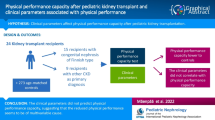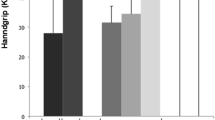Abstract
Studies of exercise capacity in children with chronic kidney disease (CKD) are limited. We tested 25 pediatric kidney transplant (TX) recipients and 15 pediatric dialysis (DX) patients. Nine children in the DX group received kidney transplants and were retested 3 months following surgery (pre/post). Testing involved treadmill testing with measurement of peak oxygen uptake (VO2peak), muscle strength, body composition (percent fat), and “field” tests of physical fitness using the FITNESSGRAM, which included the PACER test. Values obtained were compared with gender- and age-based criterion-referenced standards [healthy fitness zone (HFZ)]. The previous day physical activity recall (PDPAR) was used to assess physical activity participation. There were no differences between TX and DX subjects for VO2peak and muscle strength measurements, and all values were below the normative values. The TX group achieved significantly higher PACER scores, but only one TX and no DX subjects achieved the HFZ for the PACER test. No improvement in any measures were observed from pre- to post-TX in the nine subjects tested, except for a significant increase in percent fat, which negatively affected the change in muscle strength and VO2peak. All subjects were physically inactive, with less than 10% of nonschool time being physical activity participation. Pediatric patients with CKD had low exercise capacity, were physically inactive, and gained significant fat weight following TX. Counseling and encouragement for more physical activity is warranted as a part of routine medical care in these children.



Similar content being viewed by others
References
Painter PL, Messer-Rehak D, Hanson P, Zimmerman S, Glass NR (1986) Exercise capacity in hemodialysis, capd and renal transplant patients. Nephron 42:47–51
Painter P, Hanson P, Messer-Rehak D, Zimmerman SW, Glass NR (1987) Exercise tolerance changes following renal transplantation. Am J Kidney Dis 10:452–456
Painter PL, Moore GE, Carlson L, Paul S, Myll J, Phillips W, Haskell W (2002) The effects of exercise training plus normalization of hematocrit on exercise capacity and health-related quality of life. Am J Kidney Dis 39:257–265
Akiba T, Matsui N, Shinohara S, Fujiwara H, Nomura T, Marumo F (1995) Effects of recombinant human erythropoietin and exercise training on exercise capacity in hemodialysis patients. Artif Organs 19:1262–1268
Barnea N, Drory Y, Iaina A, Lapidot C, Reisin E, Eliahou H, Kellermann JJ (1980) Exercise tolerance in patients on chronic hemodialysis. Isr J Med Sci 16:17–21
Cheema B, Singh MAF (2005) Exercise training in patients receiving maintenance hemodialysis: A systematic review of clinical trials. Am J Nephrol 25:352–364
Goldberg AP, Geltman EM, Hagberg JM, Delmez JA, Haynes ME, Harter HR (1983) Therapeutic benefits of exercise training for hemodialysis patients. Kidney Int Suppl S16:S303–S309
Johansen KL (1999) Physical functioning and exercise capacity in patients on dialysis. Adv Ren Replace Ther 6:141–148
Kouidi E, Albani M, Natsis K, Magalopoulos A, Gigis P, Guiba-Tziampiri O, Tourkantonis A, Deligiannis A (1998) The effects of exercise training on muscle atrophy in haemodialysis patients. Nephrol Dial Transplant 13:685–699
Lundin AP, Stein RA, Frank F (1981) Cardiovascular status in long-term hemodialysis patients: An exercise and echocardiographic study. Nephron 28:234–238
MacDougall I, Lewis NP, Saunders MJ, Cochlin DL, Davies ME, Hutton RD, Fox KAA, Coles GA, Williams JD (1990) Long-term cardiorespiratory effects of amelioration of renal anemia by erythropoeitin. Lancet 335:489–493
Moore GE, Brinker KR, Stray-Gundersen J, Mitchell JH (1993) Determinants of Vo2peak in patients with end-stage renal disease: On and off dialysis. Med Sci Sports Exerc 25:18–23
Moore GE, Parsons DB, Painter PL, Stray-Gundersen J, Mitchell J (1993) Uremic myopathy limits aerobic capacity in hemodialysis patients. Am J Kidney Dis 22:277–287
Robertson RJ, Gilcher R, Metz KF (1982) Effects of induced erythrocythemia on hypoxia tolerance during physical exercise. J Appl Physiol 53:490–495
Ross DL, Grabeau GM, Smith S, Seymour M, Knierim N, Pitetti KH (1989) Efficacy of exercise for end-stage renal disease patients immediately following high-efficiency hemodialysis: A pilot study. Am J Nephrol 9:376–383
Shalom R, Blumenthal JA, Williams RS (1984) Feasibility and benefits of exercise training in patients on maintenance dialysis. Kidney Int 25:958–963
Sietsema KE, Amato A, Adler SG, Brass EP (2004) Exercise capacity as a prognostic indicator among ambulatory patients with end stage renal disease. Kidney Int 65:719–724
Zabetakis PM, Gleim GW, Pasternak FL, Saraniti A, Nicholas JA, Michelis MF (1982) Long-duration submaximal exercise conditioning in hemodialysis patients. Clin Nephrol 8:17–22
Painter PL, Tomlanovich SL, Hector LA, Ray KA, Lyons L, Paul S, Ascher NL (2002) A randomized trial of exercise training following renal transplantation. Transplantation 74:42–48
Baraldi E, Montini G, Zanconato S, Zacchello G, Zaccello F (1990) Exercise tolerance after anemia correction with recombinant human erythropoietin in end-stage renal disease. Pediatr Nephrol 4:623–626
Montini G, Zacchello G, Baraldi E, Zanconato S, Suppiej A, Faris F, Andreeta B, Pavanello L, Zacchello F (1990) Benefits and risks of anemia correction with recombinant human erythropoietin in children maintained by hemodialysis. J Pediatr 117:556–560
Martin GR, Ongkingo JR, Turner ME, Skurkow ES, Ruley EJ (1993) Recombinant erythropoietin improves cardiac exercise performance in children with end-stage renal disease. Pediatr Nephrol 7:276–280
Warady BA, Sabath RJ, Smith CA, Alon U, Hellerstein S (1991) Recombinant human erythropoietin therapy in pediatric patients receiving long-term peritoneal dialysis. Pediatr Nephrol 5:718–723
Matteucci M, Calzolari A, Pompei E, Principato F, Turchetta A, Rizzoni G (1996) Abnormal hypertensive response during exercise test in normotensiv e transplanted children adn adolescents. Nephron 73:201–206
Krull F, Schulze-Neick I, Hatopp A, Offner G, Brodehl J (1994) Exercise capacity and blood pressure response in children and adolescents after renal transplantation. Acta Paediatr 83:1296–1302
Meredith M, Welk GJ (1999) FITNESSGRAM test administration manual, 2nd edn. Human Kinetics, Champaign
Unnithan VB, Veehof SHE, Rosenthal P, Mudge C, O’Brien TH, Painter PL (2001) Fitness testing of pediatric liver transplant recipients. Liver Transpl Surg 7:206–212
American College of Sports Medicine (2000) In: Franklin BA (ed) ACSM’s guidelines for exercise testing and prescription, 6th edn. Lippincott Williams & Wilkins, Philadelphia
American College of Sports Medicine (1995) Guidelines for exercise testing and prescription, 5th edn. Williams & Wilkins, Philadelphia
Borg G, Linderholm H (1967) Perceived exertion and pulse rate during graded exercise in various age groups. Acta Medica Scand Suppl 472:194–206
Nagle FJ, Hagberg J, Kamei S (1977) Maximal O2 uptake of boys and girls ages 14–17. Eur Appl Physiol Occup Physiol 36:75–80
Gross MT, Credle JK, Hopkins LA, Kollins TM (1990) Validity of knee flexion and extension peak torque prediction models. Physl Ther 70:3–10
Leger LA, Lambert JA (1982) A maximal multistage 20 meter shuttle run test to predict Vo2 max. Eur J Appl Physiol 49:1–12
Weston AT, Petosa R, Pate RR (1997) Validation of an instrument for measurement of physical activity in youth. Med Sci Sports Exerc 29:138–144
Painter P (1992) Exercise training following organ transplant. Cardiopulm Phys Ther 3:4–8
Blair SN, Kohl HW, Paffenbarger RS, Clark DG, Cooper KH, Gibbons LW (1989) Physical fitness and all-cause mortality: a prospective study in healthy men and women. J Am Med Assoc 262:2395–2401
Krasnoff J, Mathias R, Rosenthal P, Painter P (2006) The comprehensive assessment of physical fitness in children following kidney and liver transplantation. Transplantation 82:211–217
Author information
Authors and Affiliations
Corresponding author
Additional information
Funding source
This study was supported by Satellite HealthCare Research Grants Program. This study was carried out in part in the General Clinical Research Center, Moffitt Hospital, University of California, San Francisco, with funds provided by the National Center for Research Resources, MO1 RR-0079, US Public Health Service.
Rights and permissions
About this article
Cite this article
Painter, P., Krasnoff, J. & Mathias, R. Exercise capacity and physical fitness in pediatric dialysis and kidney transplant patients. Pediatr Nephrol 22, 1030–1039 (2007). https://doi.org/10.1007/s00467-007-0458-6
Received:
Revised:
Accepted:
Published:
Issue Date:
DOI: https://doi.org/10.1007/s00467-007-0458-6




